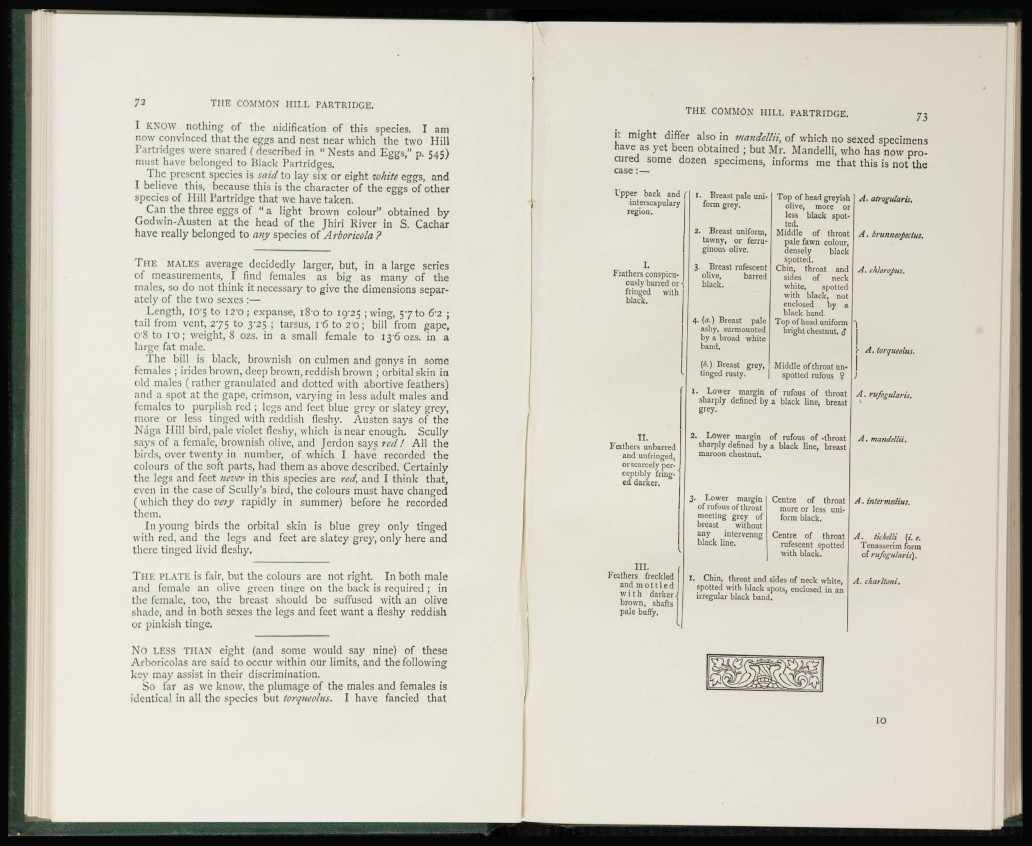
7- TIIE COMMON HILL PARTRIDGE.
I KNOW nothing of the nidification of this species. I am
now convinced that the eggs and nest near which the two Hill
Partridges were snared ( described in " Nests and Eggs," p. 545)
must have belonged to Black Partridges.
The present species is said to lay six or eight white eggs, and
I believe this, because this is the character of the eggs of other
species of Hill Partridge that we have taken.
Can the three eggs of " a light brown colour" obtained by
Godwin-Austen at the head of the Jhiri River in S. Cachar
have really belonged to any species of Arboricola ?
T H E MALES average decidedly larger, but, in a large series
of measurements, I find females as big as many of the
males, so do not think it necessary to give the dimensions separately
of the two sexes :—•
Length, 105 to I2'0; expanse, i8'0 to 19/25 ; wing, 5 7 to 6'2 ;
tail from vent, 275 to 3-25 ; tarsus, v6 to 2 0 ; bill from gape,
08 to r o ; weight, 8 ozs. in a small female to 136 ozs. in a
large fat male.
The bill is black, brownish on culmen and gonys in some
females ; irides brown, deep brown, reddish brown ; orbital skin in
old males ( rather granulated and dotted with abortive feathers)
and a spot at the gape, crimson, varying in less adult males and
females to purplish red ; legs and feet blue grey or slatey grey,
more or less tinged with reddish fleshy. Austen says of the
Naga Hill bird, pale violet fleshy, which is near enough. Scully
says of a female, brownish olive, and Jerdon says red ! All the
birds, over twenty in number, of which I have recorded the
colours of the soft parts, had them as above described. Certainly
the legs and feet never in this species are red, and I think that,
even in the case of Scully's bird, the colours must have changed
(which they do very rapidly in summer) before he recorded
them.
In young birds the orbital skin is blue grey only tinged
with red, and the legs and feet are slatey grey, only here and
there tinged livid fleshy.
T H E PLATE is fair, but the colours are not right. In both male
and female an olive green tintre on the back is required ; in
the female, too, the breast should be suffused with an olive
shade, and in both sexes the legs and feet want a fleshy reddish
or pinkish tinge.
No LESS THAN eight (and some would say nine) of these
Arboricolas are said to occur within our limits, and the following
key may assist in their discrimination.
So far as we know, the plumage of the males and females is
identical in all the species but torqueolus. I have fancied that
it might differ also in mandellii, of which no sexed specimens
have as yet been obtained ; but Mr. Mandelli, who has now procured
some dozen specimens, informs me that this is not the
case:—
Upper back and {
interscapular)- j
region.
I.
Feathers conspicuously
barred or i
fringed with
black.
II.
Feathers unbarred
and unhinged,
orscarcely perceptibly
fling-j
ed darker.
III.
Feathers freckled
and mottled
w i t h darker,
brown, shafts |
pale buffy.
. Breast pale uniform
grey.
2. Breast uniform,
tawny, or ferruginous
olive.
3- Breast rufescent
olive, barred
black.
4. (a.) Breast pale
ashy, surmounted
by a broad white
band.
Top of head greyish
olive, more or
less black spotted.
Middle of throat
pale fawn colour,
densely black
spotted.
Chin, throat and
sides of neck
white, spotted
with black, not
enclosed by a
black band
Top of head uniform
bright chestnut. 3
(A) Breast grey, Middle of throat untinged
rusty. | spotted rufous ?
. Lower margin of rufous of throat
sharply defined by a black line, breast
grey.
2. Lower margin of rufous of .throat
sharply defined by a black line, breast
maroon chestnut.
3. Lower margin
of rufous of throat
meeting grey of
breast without
any intervenng
black line.
Centre of throat
more or less uniform
black.
Centre of throat
rufescent spotted
with black.
t. Chin, throat and sides of neck white,
spotted with black spots, enclosed in an
irregular black band.
IO